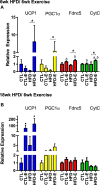Exercise Increases and Browns Muscle Lipid in High-Fat Diet-Fed Mice
- PMID: 27445983
- PMCID: PMC4928595
- DOI: 10.3389/fendo.2016.00080
Exercise Increases and Browns Muscle Lipid in High-Fat Diet-Fed Mice
Abstract
Muscle lipid increases with high-fat feeding and diabetes. In trained athletes, increased muscle lipid is not associated with insulin resistance, a phenomenon known as the athlete's paradox. To understand if exercise altered the phenotype of muscle lipid, female C57BL/6 mice fed CTL or high-fat diet (HFD for 6 or 18 weeks) were further divided into sedentary or exercising groups (CTL-E or HFD-E) with voluntary access to running wheels for the last 6 weeks of experiments, running 6 h/night. Diet did not affect running time or distance. HFD mice weighed more than CTL after 18 weeks (p < 0.01). Quadriceps muscle TG was increased in running animals and in sedentary mice fed HFD for 18 weeks (p < 0.05). In exercised animals, markers of fat, Plin1, aP2, FSP27, and Fasn, were increased significantly in HFD groups. Ucp1 and Pgc1a, markers for brown fat, increased with exercise in the setting of high fat feeding. Fndc5, which encodes irisin, and CytC were sensitive to exercise regardless of diet. Plin5 was increased with HFD and unaffected by exercise; the respiratory exchange ratio was 15% lower in the 18-week HFD group compared with CTL (p < 0.001) and 10% lower in 18 weeks HFD-E compared with CTL-E (p < 0.001). Increased Ucp1 and Pgc1a in exercised muscle of running mice suggests that a beige/brown fat phenotype develops, which differs from the fat phenotype that induces insulin resistance in high fat feeding. This suggests that increased muscle lipid may develop a "brown" phenotype in the setting of endurance exercise training, a shift that is further promoted by HFD.
Keywords: brown adipose tissue; exercise; intramyocellular lipid; running.
Figures





Similar articles
-
Effects of physical exercise on myokines expression and brown adipose-like phenotype modulation in rats fed a high-fat diet.Life Sci. 2016 Nov 15;165:100-108. doi: 10.1016/j.lfs.2016.09.023. Epub 2016 Sep 28. Life Sci. 2016. PMID: 27693382
-
Lipid droplet-associated proteins in high-fat fed mice with the effects of voluntary running and diet change.Metabolism. 2014 Aug;63(8):1031-40. doi: 10.1016/j.metabol.2014.05.010. Epub 2014 May 27. Metabolism. 2014. PMID: 24972504
-
Combination of meal and exercise timing with a high-fat diet influences energy expenditure and obesity in mice.Chronobiol Int. 2014 Nov;31(9):959-75. doi: 10.3109/07420528.2014.935785. Epub 2014 Jul 9. Chronobiol Int. 2014. PMID: 25007387
-
Skeletal muscle overexpression of nicotinamide phosphoribosyl transferase in mice coupled with voluntary exercise augments exercise endurance.Mol Metab. 2018 Jan;7:1-11. doi: 10.1016/j.molmet.2017.10.012. Epub 2017 Nov 6. Mol Metab. 2018. PMID: 29146412 Free PMC article.
-
AMPK-α2 is involved in exercise training-induced adaptations in insulin-stimulated metabolism in skeletal muscle following high-fat diet.J Appl Physiol (1985). 2014 Oct 15;117(8):869-79. doi: 10.1152/japplphysiol.01380.2013. Epub 2014 Aug 7. J Appl Physiol (1985). 2014. PMID: 25103967
Cited by
-
The association of serum irisin with anthropometric, metabolic, and bone parameters in obese children and adolescents.Front Endocrinol (Lausanne). 2024 Jan 25;14:1326851. doi: 10.3389/fendo.2023.1326851. eCollection 2023. Front Endocrinol (Lausanne). 2024. PMID: 38333723 Free PMC article.
-
Exercise Degrades Bone in Caloric Restriction, Despite Suppression of Marrow Adipose Tissue (MAT).J Bone Miner Res. 2020 Jan;35(1):106-115. doi: 10.1002/jbmr.3872. Epub 2019 Oct 25. J Bone Miner Res. 2020. PMID: 31509274 Free PMC article.
-
Impacts of rat hindlimb Fndc5/irisin overexpression on muscle and adipose tissue metabolism.Am J Physiol Endocrinol Metab. 2020 Jun 1;318(6):E943-E955. doi: 10.1152/ajpendo.00034.2020. Epub 2020 May 5. Am J Physiol Endocrinol Metab. 2020. PMID: 32369414 Free PMC article.
-
Physical activity prevents alterations in mitochondrial ultrastructure and glucometabolic parameters in a high-sugar diet model.PLoS One. 2017 Feb 15;12(2):e0172103. doi: 10.1371/journal.pone.0172103. eCollection 2017. PLoS One. 2017. PMID: 28199417 Free PMC article.
-
Effects of moderate intensity exercise on liver metabolism in mice based on multi-omics analysis.Sci Rep. 2024 Dec 28;14(1):31072. doi: 10.1038/s41598-024-82150-y. Sci Rep. 2024. PMID: 39730655 Free PMC article.
References
Grants and funding
LinkOut - more resources
Full Text Sources
Other Literature Sources
Research Materials
Miscellaneous

